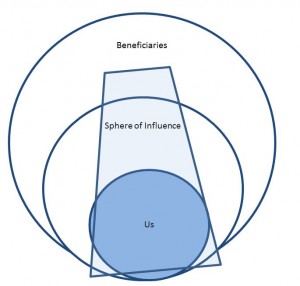In an Outcome-Based mapping approach, we do not try to reach out immediately to the beneficiaries or all the people/organizations that may have an interest in our product or service. We reach out to people/organizations that we can influence. This is quite different from the Lean StartupTM approach where we are trying to find product/market fit and reach audience. It is also different from the typical idea of finding the ideal client or target market. This is about sitting back and viewing people that we can influence in the short-term, medium-term and long term.
I contend that the typical tools such as marketing funnels, customer journeys or sales cycles limits us to Goods-dominant logic (GD-logic) thinking and prevents us from viewing from the perspective of Service Dominant Logic (SD-Logic). If that is not a big enough picture, it is what separates commoditized products/services from building an eco-system and platforms such as Starbucks, Amazon or Apple.
Amazon and Apple have both concentrated on their core and their core capabilities within their sphere of influence to increase market share and introduce products. My views of developing from core capabilities are highlighted in the Lean Scale-Up Outline. This view does not say; we don’t innovate and create new capabilities. It simply states that we do this from developing a shared understanding and co-creating with our markets. 
When we concentrate on people/organizations that we have the ability to influence, we understand new and old marketing cycles better. We are close to them so that we can understand, ask, experiment and see what obstacles are present. We look for what behavior change we need to create (short-term, medium-term and long term outcomes) to drive the desired impacts in the end beneficiaries of our product/service.
When viewing from a GD-Logic, we look at how to steer someone down a path to purchase. Even if we accomplish this, we have difficult developing long term customers that will not change when offered a better solution. The solution is the value. This leads to the most “agile” company that can adapt quickly to the market place an advantage.
In SD-Logic thinking, value creation is interactional. This allows our sphere of influence to grow because our customers are participating in the creation of value. As our influence and ability to co-create with our customers increases, our sphere of influence becomes a resource for value creation. Value creation happens as a result of our network. If we try to co-create directly with beneficiaries, without those being in our sphere influence, we will fail miserably. Our innovative capacity is increased because we are not looking in the marketplace for solutions rather we are participating in the marketplace and are part of the solution.
Lean Sales and Marketing: Learn about using CAP-Do
Special Marketing with Lean Book and Program offers on Facebook

Comments are closed.